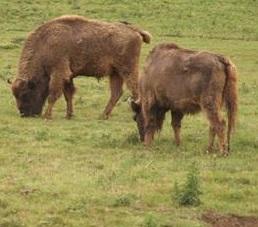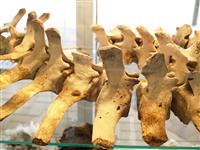Study Vertebrate Zoology
 A foundation for further studies or work with animals
A foundation for further studies or work with animals- A courses for aspiring biologists, or anyone with a passion for animals -pets, wildlife or farm animals.
- Commence study any time and study at your own pace
This is a terrific course for people who want to learn more about animals or are currently working in animal care, protection, management or veterinary science. The course covers all of the vertebrate classes in detail and will help you to differentiate between them.
ACS Student Comment: I am thoroughly enjoying the
Vertebrate Zoology course with ACS. Dr. Browne has been a wonderful
tutor and has given clear, concise and constructive feedback on each of
the assignments I have submitted. The structure of the course allows you
to independently research topics guided by module notes, set tasks and
assignment questions. The more you put into this course the more you
take away. I love the suggestions of where and how to do the set tasks.
Dissecting a grey mullet for Assignment 2 was thus far the best part of
the course – while it is only suggested to approach in this manner you
should consider making it a requirement of the module. I was able to
coordinate with a local fisherman in association with a fish monger -
they happily caught and presented me with a beautiful specimen. After
dissection it made a great meal for my four legged friends (Nothing
wasted and absolutely ethical! :). The hands-on approach enabled me to
get a very comprehensive understanding of the anatomy of a fish. The
gizzard of the grey mullet was a bonus and had I not dissected - I would
not have been able to fully appreciate the complex digestive system of
this omnivorous fish. Today I’m off to the Eagles Flying raptor research
center to meet with the biologist who runs the center – he’s allowing
me to spend the day observing barn owls for my current module. Yet,
another brilliant experience thanks to my enrolment at ACS. Jessica, Vertebrate Zoology course.
COURSE STRUCTURE
 The course is divided into ten lessons as follows:
The course is divided into ten lessons as follows:
1. Vertebrate Taxonomy and Diversity
2. Fishes
3. Ectotherms: Amphibians and Reptiles
4. Birds
5. Overview of Mammals
6. Marsupials
7. Mammalian Glires and Insectivora
8. Carnivores
9. Hooved Mammals: Ungulata
10. Primates and other Archonta
Aims
Upon completion of this course, the student will be able to:
- Distinguish between major groups of vertebrates through a demonstrated understanding of their taxonomic classification and diversity.
- Describe the distinguishing characteristics of all major groups of fishes.
- To describe the distinguishing characteristics of all major groups of Ectotherms, Amphibians and Reptiles.
- Describe the distinguishing characteristics of major groups of birds
- Describe the distinguishing characteristics of all major groups of Mammals.
- Describe the distinguishing characteristics of animals in the order Marsupialia and compare mammalian specialisations with those of other vertebrates.
- Describe the distinguishing characteristics of animals within the grandorders Glires and Insectivora. Explain Ectothermy in a variety of different animals.
- Describe the distinguishing characteristics of animals within the order Carnivora.
- Describe the distinguishing characteristics of animals within the grand order Ungulata.
- Describe the distinguishing characteristics of animals within the grandorder Archonta.
Duration: 100 hours of self-paced study
THE CLASSIFICATION OF HIGHER ANIMALS
Although the term “Higher Animals” is well established in both common and scientific language as a synonym for vertebrates, we should bear in mind that there are other groups of animals that are highly developed, namely insects and cephalopods.
Phylum Chordata
The subphylum Vertebrata is placed within the phylum Chordata. Most chordates are bilaterally symmetrical animals with differentiation into head, trunk, and tail.
As a rule, chordates are active animals. The most distinctive anatomical features of chordates are a notochord and nerve cord. The notochord is an exceptionally important characteristic of chordates. It is like a stiffened rod that does not compress. This allows the body muscles to act against the notochord and thus allows the animal to move.
The phylum Chordata includes three subphyla:
1. Subphylum Acrania includes about 30-35 contemporary species placed in one class and three families. All are marine animals. Look like small (~10 cm or smaller) semi-transparent fish.
2. Subphylum Urochordata (Tunicata) consists of three classes of exclusively marine animals.
2.1 Class Ascidia includes about 1,000 contemporary sessile filter-feeding animals also called Sea Squirts. Order Synacidiae includes species living in colonies, while order Monoscidiae includes solitary animals.
2.2 Class Thaliacea (Salpae) includes about 70 contemporary pelagic filter-feeder species shaped like a barrel, and is divided into three orders. Order Pyrosomidae consists of species living in colonies: orders Salpidae and Doliolidae consist of solitary species.
2.3 Class Appendiculariae includes about 60 small (several millimeters) pelagic species.
3. Subphylum Vertebrata includes animals with a distinct internal skeleton. They are multicellular animals derived from embryos that have three cellular layers: endoderm (endo- internal), mesoderm (meso- medium) and ectoderm (ecto- external). They have bilateral symmetric bodies, and internal gut with two openings, mouth and anus. Only Vertebrates have a true brain with several different areas and a skeletal structure that protects the brain, the cranium. They have developed sensory organs (eyes, ears, olfactory organs). They posses a more complex digestive system, with several accessory digestive glands. The heart is chambered. They have developed more complex respiratory and muscular systems as well.
Classes within Vertebrata include:
-
Cyclostomata (Lampreys and Hagfish)
-
Chondrichthyes (Sharks, Skates and Rays, Elephant Fishes)
-
Osteichthyes (Bony Fishes) (Choanichthyes (Lungfish) separated from this class by some researchers)
-
Amphibia (Amphibians – Frogs and Toads, Newts and Salamanders, Caecilians)
-
Reptilia (Crocodiles, Lizards and Snakes, Turtles and Tortoises, Marine Iguanas)
-
Aves (Birds)
-
Mammalia (Mammals)
 MORPHOLOGY AND EVOLUTION
MORPHOLOGY AND EVOLUTION
Morphology is the study (-logy) of forms (morpho-). Animal morphology studies not only animal form, but also why animals develop in a certain way.
To understand why an animal part or structure is as we know them today, we have to study what pushes evolution in a certain path and not in another direction.
There are two major factors that determine evolution:
Environment determines animal form by providing opportunities for better survival and reproduction. Environment provides for unoccupied habitats or ecological spaces (niches) where it is advantageous to develop structures or to use existing ones differently, to make the animal better suited to their environment, that is, to survive better as an individual or as a species. Thus environment puts limitations to animal evolution, and encourages certain evolutionary paths.
Morphological changes are also determined by genetics. A certain structure may change in a certain way, because there is a genetic possibility that allows for that change. But an animal cannot develop a structure when there are no genes that could be modified to develop the new structure. There must be a genetic predisposition. A primate cannot develop feathered wings because the feathered wing genes were not in primitive mammals’ evolution.
Genes are changing constantly, although the rate of change may be very slow. Genetic change is accelerated though when environmental changes are quicker. Evolution has been faster in geological times where environmental instability has been the highest.
Environment determines animal behaviour, and behaviour determines evolution as well. Animal behaviour is determined by basic survival needs:
- Feeding
- Reproducing
- Surviving predation
Any structural change that reinforces or facilitates the three functions above will be promoted if there is genetic resources for it.
The effects of evolution in animal morphology can be classified in two main types:
- Speciation
- Diversification
Why Study with ACS?
Design your own learning pathway.
Study at your own pace, from anywhere, at any time.
Receive prompt, expert support from our team of committed and friendly tutors.
Your learning is our priority. We are flexible and adaptable to meet your educational needs!
Want advice on creating a learning pathway that suits your needs? Speak to one of our friendly staff for today!
Phone - International: +61 7 5562 1088 In Australia: 07 5562 1088
Email - admin@acs.edu.au or studentservices@acs.edu.au